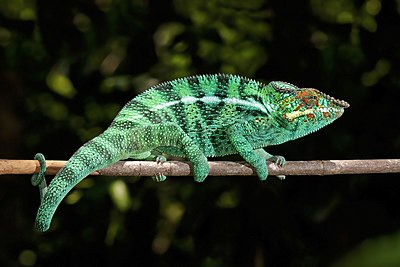Talk:Panther chameleon
| This article is rated Start-class on Wikipedia's content assessment scale. It is of interest to the following WikiProjects: | |||||||||||
| |||||||||||
Avoid common name "Reunion Island chameleon"
[edit]I noticed "Common Names for Panther Chameleon (Furcifer pardalis )". Encyclopedia of Life. lists Reunion Island chameleon as an alternative common name, and almost added it here. EOL's source was AnAge, which listed their source as "Frank & Kate's Web Page," which from google searches seems to have originated the term. I would guess they misinterpreted someone describing the geographic origin of a chameleon, a "Chameleon Island chameleon," as the name of the animal. Agyle (talk) 05:40, 24 December 2013 (UTC)
More than "a species"
[edit]Through DNA testing, biologists at the University of Geneva and the University of Antananarivo recently discovered that what was assumed to be one species of panther chameleon with a wide range of color displays is actually 11 species of similar-looking chameleons with characteristic color displays that are useful in differentiating them. — QuicksilverT @ 16:26, 26 May 2015 (UTC)
- The paper is here: http://onlinelibrary.wiley.com/doi/10.1111/mec.13241/abstract
- However, it's crucial to note that found 11 distinct haplotypes that *could* correspond to "species", or "subspecies", but the authors do not formally describe these species. The paper states "Still, the combination of our phylogeographic and supervised machine learning analyses suggests, but does not unambiguously indicate, that panther chameleons require being separated into multiple species, with a minimum of four corresponding to the bifurcation graph defined by the classification key shown in Fig. 4: the monophyletic haplogroup A1b, the paraphyletic group(A1a + A2 + A3 + A4), the monophyletic haplogroup C1 and the paraphyletic group (B + C2). In case our result sare confirmed, taxonomic revision would be warranted." Thus, this information must be added carefully, perhaps saying something like "Recent work has shown that the regional color differences correspond to genetic differences, which may warrant elevating the populations to species status". Until actual species formal descriptions are published, there's still only one species according to ICZN rules. HCA (talk) 17:25, 26 May 2015 (UTC)
I am deleting the "captive care" section
[edit]I am going to take the initiative to delete the captive care section, though I'd invite any more established editors more versed in the rules of Wikipedia to confirm/overrule the decision. The reasons I think this section should be removed are: 1) My understanding is that it is against Wikipedia policy to have "how to" sections, 2) There are no citations, and 3) Much of reptile husbandry information (even when correct) has been discovered by hobbyists through trial and error, and then shared online via message boards or husbandry manuals (neither of which remotely approach peer reviewed). Though this information may be accurate, it is often full of assumptions and untested hypotheses and has no business being included in an encyclopedia. Connorlong90 (talk) 02:39, 1 February 2018 (UTC)
Featured picture scheduled for POTD
[edit]Hello! This is to let editors know that the featured picture File:Panther chameleon (Furcifer pardalis) male Nosy Be.jpg, which is used in this article, has been selected as the English Wikipedia's picture of the day (POTD) for August 17, 2021. A preview of the POTD is displayed below and can be edited at Template:POTD/2021-08-17. For the greater benefit of readers, any potential improvements or maintenance that could benefit the quality of this article should be done before its scheduled appearance on the Main Page. If you have any concerns, please place a message at Wikipedia talk:Picture of the day. Thank you! Cwmhiraeth (talk) 10:06, 8 August 2021 (UTC)

|
The panther chameleon (Furcifer pardalis) is a species of lizard found in tropical forests in the eastern and northern parts of Madagascar. Like all chameleons, the species exhibits a specialized arrangement of toes in which the digits are fused into a group of two and a group of three. On the forelimbs, there are two toes on the outer side of each foot and three on the inside, with the arrangement reversed on the hind legs. Their specialized feet allow them a tight grip on narrow branches, and their sharp claws give them traction when climbing on bark. This male panther chameleon was photographed on the island of Nosy Be, off the northwestern coast of Madagascar. Photograph credit: Charles James Sharp
Recently featured:
|
Color Change
[edit]There's no information to be found concerning the range of their color changes or very much on when/why their color changes. Panicko7 (talk) 16:10, 17 April 2023 (UTC)
- The range of colors of an individual animal varies with locality; IMO the when/why seems like it might be more appropriate for a chameleon page in general (family probably) as opposed to a specific species, unless there are species specific citations you have in mind. Connor Long (talk) 06:07, 21 April 2023 (UTC)
- I have no specific citations in mind for this chameleon, but looking at the veiled chameleon page for reference I thought I could find similar information on the reasons behind the color changes in the panther chameleon specifically. Panicko7 (talk) 15:47, 24 April 2023 (UTC)
